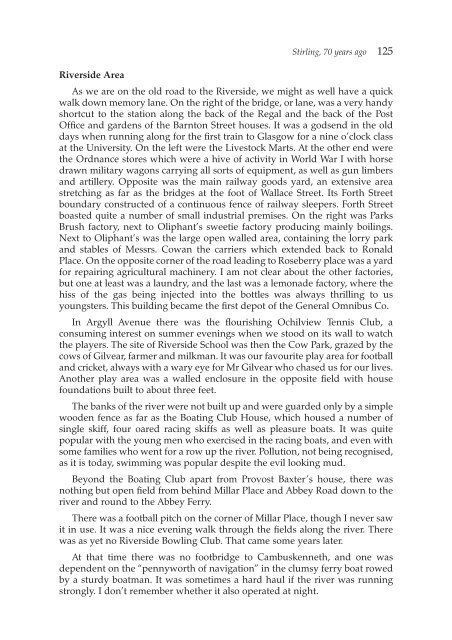the Forth Naturalist Historian - Forth Naturalist and Historian ...
the Forth Naturalist Historian - Forth Naturalist and Historian ...
the Forth Naturalist Historian - Forth Naturalist and Historian ...
You also want an ePaper? Increase the reach of your titles
YUMPU automatically turns print PDFs into web optimized ePapers that Google loves.
Stirling, 70 years ago 125<br />
Riverside Area<br />
As we are on <strong>the</strong> old road to <strong>the</strong> Riverside, we might as well have a quick<br />
walk down memory lane. On <strong>the</strong> right of <strong>the</strong> bridge, or lane, was a very h<strong>and</strong>y<br />
shortcut to <strong>the</strong> station along <strong>the</strong> back of <strong>the</strong> Regal <strong>and</strong> <strong>the</strong> back of <strong>the</strong> Post<br />
Office <strong>and</strong> gardens of <strong>the</strong> Barnton Street houses. It was a godsend in <strong>the</strong> old<br />
days when running along for <strong>the</strong> first train to Glasgow for a nine o’clock class<br />
at <strong>the</strong> University. On <strong>the</strong> left were <strong>the</strong> Livestock Marts. At <strong>the</strong> o<strong>the</strong>r end were<br />
<strong>the</strong> Ordnance stores which were a hive of activity in World War I with horse<br />
drawn military wagons carrying all sorts of equipment, as well as gun limbers<br />
<strong>and</strong> artillery. Opposite was <strong>the</strong> main railway goods yard, an extensive area<br />
stretching as far as <strong>the</strong> bridges at <strong>the</strong> foot of Wallace Street. Its <strong>Forth</strong> Street<br />
boundary constructed of a continuous fence of railway sleepers. <strong>Forth</strong> Street<br />
boasted quite a number of small industrial premises. On <strong>the</strong> right was Parks<br />
Brush factory, next to Oliphant’s sweetie factory producing mainly boilings.<br />
Next to Oliphant’s was <strong>the</strong> large open walled area, containing <strong>the</strong> lorry park<br />
<strong>and</strong> stables of Messrs. Cowan <strong>the</strong> carriers which extended back to Ronald<br />
Place. On <strong>the</strong> opposite corner of <strong>the</strong> road leading to Roseberry place was a yard<br />
for repairing agricultural machinery. I am not clear about <strong>the</strong> o<strong>the</strong>r factories,<br />
but one at least was a laundry, <strong>and</strong> <strong>the</strong> last was a lemonade factory, where <strong>the</strong><br />
hiss of <strong>the</strong> gas being injected into <strong>the</strong> bottles was always thrilling to us<br />
youngsters. This building became <strong>the</strong> first depot of <strong>the</strong> General Omnibus Co.<br />
In Argyll Avenue <strong>the</strong>re was <strong>the</strong> flourishing Ochilview Tennis Club, a<br />
consuming interest on summer evenings when we stood on its wall to watch<br />
<strong>the</strong> players. The site of Riverside School was <strong>the</strong>n <strong>the</strong> Cow Park, grazed by <strong>the</strong><br />
cows of Gilvear, farmer <strong>and</strong> milkman. It was our favourite play area for football<br />
<strong>and</strong> cricket, always with a wary eye for Mr Gilvear who chased us for our lives.<br />
Ano<strong>the</strong>r play area was a walled enclosure in <strong>the</strong> opposite field with house<br />
foundations built to about three feet.<br />
The banks of <strong>the</strong> river were not built up <strong>and</strong> were guarded only by a simple<br />
wooden fence as far as <strong>the</strong> Boating Club House, which housed a number of<br />
single skiff, four oared racing skiffs as well as pleasure boats. It was quite<br />
popular with <strong>the</strong> young men who exercised in <strong>the</strong> racing boats, <strong>and</strong> even with<br />
some families who went for a row up <strong>the</strong> river. Pollution, not being recognised,<br />
as it is today, swimming was popular despite <strong>the</strong> evil looking mud.<br />
Beyond <strong>the</strong> Boating Club apart from Provost Baxter’s house, <strong>the</strong>re was<br />
nothing but open field from behind Millar Place <strong>and</strong> Abbey Road down to <strong>the</strong><br />
river <strong>and</strong> round to <strong>the</strong> Abbey Ferry.<br />
There was a football pitch on <strong>the</strong> corner of Millar Place, though I never saw<br />
it in use. It was a nice evening walk through <strong>the</strong> fields along <strong>the</strong> river. There<br />
was as yet no Riverside Bowling Club. That came some years later.<br />
At that time <strong>the</strong>re was no footbridge to Cambuskenneth, <strong>and</strong> one was<br />
dependent on <strong>the</strong> “pennyworth of navigation” in <strong>the</strong> clumsy ferry boat rowed<br />
by a sturdy boatman. It was sometimes a hard haul if <strong>the</strong> river was running<br />
strongly. I don’t remember whe<strong>the</strong>r it also operated at night.



